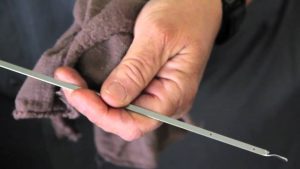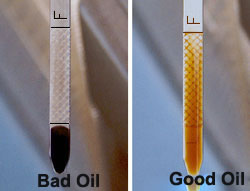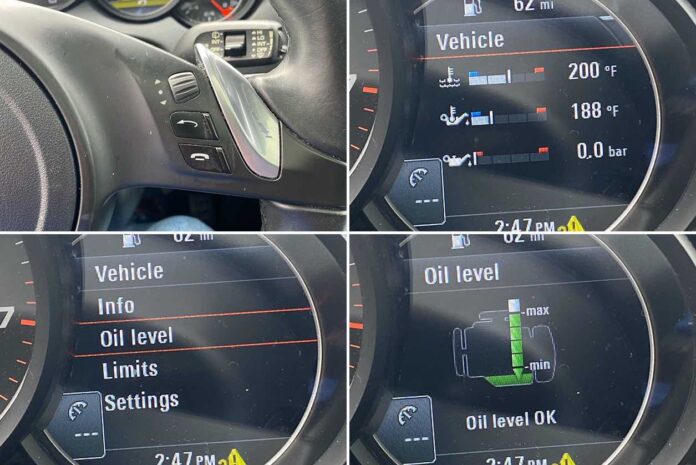Things start at the top and work their way down.
For instance, the flatscreen displays that are now standard in pretty much all new vehicles (very few cars are being made anymore). These first appeared about a decade ago in top-of-the-line luxury-brand vehicles and made them appear to be more top-of-the-line because less-expensive makes and models did not have them.
Now that they all do, it no longer looks as top-of-the-line. It actually looks kind of common. And it may be worse than just how it looks.
This brings up another feature that first appeared in top-of-the-line vehicles. Or rather, disappeared from them.
The dipstick.
For more than 100 years, the way you checked whether there was the proper amount of oil in your vehicle’s engine was to raise the hood and pull the dipstick out from the metal tube it fit into, wipe it off with a rag or paper towel, reinsert it, remove it – and look at it. You used your eyes to see whether the oil level was approximately at the “full” mark on the dipstick and if it wasn’t, you added oil until it was. You also looked at the oil, which served as a measure of its condition. If the oil was black, that was a clue it had not been changed in a while and probably ought to be.
The dipstick itself could also provide a clue as to how a vehicle’s engine was maintained. If the oil wasn’t changed often or the engine was run hard and hot, the dipstick would sometimes be discolored by varnish. This was helpful in terms of avoiding a prospective used car that had been abused by its prior owner.
Dipsticks are also simple, reliable and inexpensive things – like the mechanical throttle cables that have disappeared from under the hoods of new vehicles, in favor of “drive-by-wire” electronically controlled throttles that are not simple or inexpensive when the electronics stop working and the components need to be diagnosed and replaced with new electronic components.
They – dipsticks – rarely break because there’ not much too break. If the metal tube that’s pressed into the side of the engine block breaks, you pull it out and press in a new one. If the dipstick itself breaks – which is almost impossible unless you purposely bend it – you just buy a new one and insert it.
Well, all of that is in the process of going away – like throttle cables and gauges that aren’t LCD displays.
The 2025 Ram 1500 pick-up I recently test-drove (reviewed here) has a new in-line six cylinder engine that replaces the V8 you can’t get anymore. You could check the V8’s oil level by popping the hood and having a look at the dipstick. To check the new six’s oil level, you scroll through the LCD display inside the truck and tap the app. The oil level is then displayed on the screen.
There is no dipstick.
This is how you check the oil without actually looking at the oil. So you can’t tell how it looks. You also can’t look at the dipstick, itself – which (again) is no longer there. So it’s hard to see – or will be, down the road – whether the engine was run hot and hard. And of course, you must trust that the electronics are working and giving you accurate information as regards the oil level.
Probably, they are.
Until the day comes when the electronics stop working. Or the the LCD display stops displaying. At that point, there will no longer be a way to check the oil level anymore. You’ll have to assume – and remember. You’ll also have to trust – that the oil change place didn’t over (or under) fill the engine.
Probably, this won’t be a problem for the first and even the second owner. In general, the electronics in late-model vehicles are pretty reliable. But they are still electronics and these eventually fail, as mechanical things eventually fail. But when electronic things fail, it is often a more difficult thing to figure out what, exactly, has failed – and a more expensive thing to replace whatever the component is that failed. Often, because there are components – plural- involved in a system that must be diagnosed before it can be brought back to working order. And – with electronics – the components are often specific to that particular make/model/year vehicle and – after a decade or so – may no longer be available.
If they aren’t, what are you going to do?
The Stoics believed that – as guiding principle – simpler is usually better.
They were probably right about that, too.
. . .
If you like what you’ve found here please consider supporting EPautos.
We depend on you to keep the wheels turning!
Our donate button is here.
If you prefer not to use PayPal, our mailing address is:
EPautos
721 Hummingbird Lane SE
Copper Hill, VA 24079
PS: Get an EPautos magnet or sticker or coaster in return for a $20 or more one-time donation or a $10 or more monthly recurring donation. (Please be sure to tell us you want a magnet or sticker or coaster – and also, provide an address, so we know where to mail the thing!)
If you like items like the Baaaaaa! baseball cap pictured below, you can find that and more at the EPautos store!












Some dipstick stories. My mechanic had a 396 Chevelle come into his shop with a knocking engine but the dipstick showed that it had plenty of oil. Turns out the oil leaked out over the winter and the storage building owner had cleaned up the leak and neglected to tell him. The full dipstick was due to the incorrect dipstick for the engine and it was just going flat on the bottom of the pan. From what I remember it needed new bearing and either a new crank or polishing it.
I’ve got a car with a drip from the tranny. It’s not an excessive leak and I usually just top it up on mileage but without a dipstick it would be a nightmare. The cost to replace the leaking seal is probably double the value of the car and the tranny works perfectly otherwise.
My first recollection of the missing dip-stick shtick was when I realized my ’05 Malibu Maxx didn’t have a dip-stick for the transmission.
Thanks for calling this out, I just ranted about this to my friends. I have a Porsche SUV and checking the oil level requires a secret handshake. Whenever you open the hood, it disables the oil level indicator completely, says it’s “not available” and it takes about 20 miles of driving to get a readout.
I bought a scan tool which can read that sensor, but I get a raw value, like “749”. I don’t have any idea what 749 means in terms of empty/full. It’s fristrating.
VW and Audi have been going the no dipstick for awhile now, not all models though. Most, but not all models without the dipstick do have the dipstick tube though, with a cap on it. When I get one of these in the shop I just use the dipstick that I have hanging on the wall to check the level. On some models it’s a pain in the ass to use the level indicator. Engine has to be warm, but not hot, you have to wait a few minutes after shutting off the engine for it to show up on the screen, and some cars require that the hood is closed for it to register, so when you’re trying to add some you have to close the hood, wait, and if you have to add some more, open the hood…..
Hey Eric, by the way, I have a great way to make extra money at home, click the link for more info. lol!
A good carpenter’s square, the original slide rule, has an inch scale in hundreths of an inch. You’ll need a divider to measure 100ths of an inch.
A 5/12 pitch on a roof is an appealing sight for the eye, better than 6/12. The number 10 is better than the number 12 for architectural reasons.
Water levels are measured tenths of a foot at rivers.
Rain gauges are in tenths of an inch.
A base 12 system at work, like time measurements.
You can still use uneven numbers for the best results.
>A 5/12 pitch on a roof is an appealing sight
Pythagorean triple: 5,12,13 5^2 + 12^2 = 13^2
So, the length gain for a common rafter is exactly 1″ per foot of run.
Which makes it fairly easy to calculate rafter lengths.
Roof angle in degrees = 22.62, which is very close to pi/4, or 1/8 of a circle.
>number 10 is better than the number 12 for architectural reasons.
I disagree. Twelve is a better basis for a number system, IMO.
The only reason we use 10 is that we humans are “digitally deprived,” i.e. not enough fingers to count to twelve on two hands. Since cartoon characters are frequently drawn with three fingers and a thumb, to save time back in the days of hand animation, Mickey Mouse & friends probably use octal (base 8).
>A good carpenter’s square
(such as my stainless steel Stanley, with tapered tongue)
Has rafter length factors in 100ths, but is obsolete as a calculation tool in today’s world, where ft-in calculators exist.
https://www.calculated.com/prd102/Construction-Master-Pro-Trig-4080-Construction-Calculator.html
I have worn out, dropped and broken. or lost/had stolen, several CI ft-in calculators in my career, starting with one of the very first model they ever made. I only wish they used RPN.
However, if you have a CAD system, such as AutoCAD, which has a LISP interpreter built in, it is fairly easy to cobble together a ft-in calculator which uses RPN, since it is nothing more than a simple stack.
Here is one such, free for the download:
https://www.tktn.com/utilities/RPN.lsp
It was my understanding that there would be no math.
Another BAD Ford/Mazda 2.3L MZR Engine.
Burns/uses oil….don’t check oil level…engine failure….
See inside of engine after failure…..interesting….
https://www.youtube.com/watch?v=teGD_cy92Ec
Buying a used car at an auction….dangerous…
I bought a 1988 honda Civic 1.5 lt. 5 speed, at an auction about 17 years ago…paid $750…didn’t get a chance to test drive it….paid for it….pulled on to the main road…floored it…looked in rearview mirror…smoke…lol…drove it for another 30,000 miles, then scrapped it….only thing I replaced was a rad…did it myself…cost $100….
I took it once to a quick oil change…afterwards the oil consumption rose….I did the next oil change…crawled under the car…..the oil filter was loose…they didn’t torque it down….the reason for high oil consumption….
You have to do everything yourself…it is near impossible to get good car repairs done…even at dealers for $130 HR….
Whenever you get repairs done…check for all the bolts not tightened….you will find some….after paying $130 HR for a moron to fix it….
Like lawnmowers. Brggs and others have stopped drilling drain plug holes. So you can’t do a oil chabge. To do a oil change you have to turn the mower upside down. The manuals say no oil changes needed. Just add the oil that it used and fill to the top. It’s amazing how cheapo these companies will go.
You can use a suction gun, available at most auto parts stores. These are commonly used to fill differentials and manual transmissions but can also be used to remove fluids as well.
“The manuals say no oil changes needed.”
I had a JD snowblower from the 80s and a 20 year old Honda mower. I’ll stick with changing oil, thanks.
“You can use a suction gun, available at most auto parts stores.”
Yeah, this is the way to go anyway. The drain plug in my Honda was in a stupid place and always made a mess.
just got a new briggs engine to replace an old one on my log splitter. it too says no oil changes or dipstick. Eric can you find out what this justification is?
It does look, start and run way better than the old one did even when it was new
Hi Chris,
I’ll see what I can find but my bet is the “justification” is to assure you’ll need to buy a new engine sooner rather than later! One of my mowers has no dipstick, either. You have to turn the thing upside down to empty the oil. But worth doing.
Let’s check the oil. No dipstick needed, just a few numbers.
1000x1000x1000=1,000,000,000
Meters can be the unit of measurement.
If you fill one cubic kilometer with water, 1000 liters of water will be one cubic meter that weighs one metric ton, 1000 kilograms.
So, one kilometer cubed will weigh 1,000,000,000,000 kilograms.
One billion metric tons. Extrapolate to the entire earth’s water surfaces and depths, the number of metric tons of water on the earth is a hefty one, massive, in fact.
How much oil in one cubic meter? 42 gallons times 6.2 pounds per gallon, 42×6.2=260.4 pounds.
It’ll be approximately 7.7 barrels of crude oil to weigh 2000 pounds. That will be close to 1294 quarts. 1000 liters in a cubic meter, the oil by weight will occupy more than a cubic meter.
100,000,000 barrels consumed in a day, 3.65 billion barrels in a year.
474 million cubic meters of oil consumed in one year. 3.65 billion divided by 7.7 barrels will be the volume of oil in cubic meters.
One barrel weighs 260.4 pounds, 260.4 times 3.65 billion barrels weighs 950,460,000,000 lbs.
The earth should be weighing less by close to 500,000,000,000 lbs every year 3.65 billion barrels of oil is consumed, have to include oil in use but not burned, have to compensate for oil still here that humans accumulate.
Therefore, the earth’s mass is less, it should be speeding up in its flight around the sun.
Maybe the math is incorrect in some spots, but you get the idea.
It’s wild ride.
First of all, let’s get rid of the term “fossil fuels”.
Naturally-occurring hydrocarbons are “abiotic”.
Hydrocarbon products are constantly being created deep within the earth by yet-unknown processes well below the layers that contain fossils. Keep in mind that hydrocarbons migrate upward and pass through “fossil layers” picking up remnants of “fossil” material; hence, the present-day scientists’ stupid mistaken assumption that hydrocarbons are derived from “fossils”.
Oil interests are drilling wells at 5,000 feet, 10,000 feet, and 15,000 feet and deeper, and coming up with oil deposits well below the layers and levels where “fossils” were known to exist.
As Russia gained much expertise in deep-well drilling and coming up with oil deposits far deeper than that of the level of “fossils”, abiotic oil at extreme depths was actually a Russian “state secret” for a long time.
“Peak oil” and “fossil fuels” are discredited dishonest concepts that environmentalists and others are latching on to, in order to display their hatred of oil being a renewable resource as well as to push prices up.
Follow the money.
Naturally-occurring hydrocarbons have done more to advance civilization than any other influence. It is the discovery, creation and utilization of ENERGY that propels civilizations upward and onward.
We have more oil underneath our feet than the rest of the world. In fact, we became energy independent under Trump. That trend was reversed with the Biden regime.
For a good treatise on abiotic oil, please google L. Fletcher Prouty. He is a scientist who gives a good explanation of “abiotic oil”.
Drumphish,
Assuming your math is correct, it still doesn’t matter. The CO2 and H2O emitted as a result of the combustion of the oil doesn’t just flee the Earth. Very infrequently, some of those molecules might make escape velocity, but keep in mind that they are heavier than the nitrogen and oxygen composing the rest of the atmosphere. H2O becomes a part of the hydrological cycle, and CO2 might be taken up by plant life, become carbonates or just remain in the air.
Thus, Earth’s mass balance is conserved upon the combustion of oil or other hydrocarbons.
But it IS a wild ride. 😉
> Earth’s mass balance is conserved
Thanks. 🙂
Somebody had to say it…
The oil is gone from the earth, maybe half in the atmosphere in the form of emissions, the other half is in the real world here on earth.
A change in the mass balance, yet remains as such. Not all of the time.
I read that everyday the earth has a gain of 4000 tons of space particles of one form or another, the mass balance is not stable nor constant.
A meteorite here and a meteorite there will add up.
Chicxulub added some weight, gave the earth the what for.
The tsunami traveled 1200 miles to where ocean marine life fossils have been discovered to have mixed with fresh water fish fossils. They breathed in micro particles from the explosion and impact, they died. It was a whale of an impact. The deposits are there in the real world. What was near the Earth’s equator ended up 47 degrees north in latitude.
Everything changes.
The earth is booking along at 18.5 miles per second, it leaves a swirl of a vortex. Some of the atmosphere might slough off the planet and back into space.
My 1924 Ford didn’t have a dipstick, it had 2 peacocks. If oil ran out the top one, it was overfilled, and if it didn’t run out the bottom it was not long for this world and you would soon be pouring new Babbitt in the bearing journals. We are devolving.
And I’m so grateful to have a bunch of old cars around, they will be the only things moving other than horses in 20 years.
Petcocks! Autocorrect makes my point for me!
Pendejos. Estupidos. Cretinos. Idiotas.
and in French: Connards
‘there will no longer be a way to check the oil level anymore’ — eric
This is objectionable on two counts:
1. Redundancy. If the electronic indicator is broken, or the battery is dead, or (as Eric pointed out) you just want to LOOK at the oil without draining it, a dipstick is a cheap, simple backup. Considering all the useless crap that’s included in vehicles whether you want it or not, is a three-dollar freaking dipstick now a luxury that’s unobtainable at any price?? BAH! *smacks desk with a vicious thud*
2. Visual clutter. I just spent a couple of minutes studying the photo at top right. Since there’s no text, first I had to work out the thermometer-in-water and thermometer-in-oil can icons. Evidently the plain oil can at the bottom is supposed to represent pressure, I infer from the ‘bar’ label — a metric unit (1 bar = 14.5 psi) which some Americans won’t get. Whereas OIL PRES psi would be instantly comprehensible.
Then in the middle are horizontal bar indicators, with the white bar broken into four sections (does that mean something?). Then tiny blue and red dashes above the bar, which I suppose may signify ‘too low’ and ‘too high’ respectively. Then digital readouts at right, which are somewhat but not totally redundant to the unscaled bar indicators.
There’s also a little icon doohickey at lower left — a half arc with a needle and three dashes under it — that I don’t have a clue what it means. Plus a spurious yellow caution triangle, and evidently, a menu to scroll through.
This is crap human interface design, compared to dial gauges. Exactly this sort of ambiguous, obscure, ham-handed visual communication has caused accidents in nuclear plants. I’m not having it.
In fact it reminds me of the four ‘idiot lights’ in the dashboard of our 1964 Chevrolet, but ‘upgraded’ into colorful little icons for the iPhone generation:
https://i.ebayimg.com/images/g/BsUAAOSwz9ljYTYH/s-l1200.webp
Now we have moron menus instead, thanks to cheap chips.
>plain oil can
Are you sure it is an oil can and not an oil lamp? Who knows?
Maybe Aladdin wuz here. Not Kilroy, though.
According to wikipedia:
https://en.wikipedia.org/wiki/Bar_(unit)
Bar is “metric,” but not an official SI unit. Evidently it is not French enough, having been invented by a Norwegian weather forecaster, in which context many people will be familiar with the unit, except expressed as 1000 millibars. Go figure.
What is important in a unit of measure? Well, one thing is to be able to lay your hands on a copy of the standard, or a reasonably close approximation. Inches, feet, cubits and fathoms as units of length are good examples. Cm are not. Height of a column of liquid (H2O, Hg) as a measure of pressure is another. Doesn’t really matter whether the height of the column is measured in inches or centimeters. What matters is what relation it bears to “normal” for the process involved, as well as how easy it is to create a measuring device which uses that unit.
Now we come to matters of scale. A mercury manometer is easy enough to set up. So is a sight glass for a water column, especially in case the pressure drop is small enough to be measured in inches of water, not feet of water or inches of mercury. Such sight glasses are fairly common in chemical plants, in my experience.
The tire pressure gauge depicted in the Wikipedia article is an example of stunningly poor interface design. How so? The pendejo who “designed’ it set full scale to read 10 bar, though the range of pressures likely to be encountered is 0-4 bar, at least for passenger cars, light trucks, motorcycles, and bicycles. It is a prime example of what I call “decimocentric stupidity,” by which I mean fascination or obsession with the number ten.
So far, we have not been compelled to buy or sell eggs, cookies or donuts in packages of ten, but who knows? Or to convert to the ten (metric) hour day, let alone the 100 (metric) degree circle.
There is one excellent reason to use twelve, not ten, as the basis of a number system, which is that twelve is divisible by three, whereas ten is not. Surveyors use 360 as the number of divisions of a circle, plus 1/60 of 1/360 and 1/60 of 1/60 of 1/360. This choice is not arbitrary.
American builders and architects use 1/12, not 1/10, of a foot as standard, again for good reason. Further subdivisions of the foot are simply negative powers of two (i.e., divide by two, a.k.a. cut it in half). Using this system, we end up with1/96 of a foot (1/8 inch), rather than 1/100 of a foot (who knows what bastard unit that would be? Yet, American civil engineers use it.).
Many years ago when I was in school, the instructor in a class I took challenged us, as an exercise, to come up with original systems of measurement, and as I recall, to justify our choices. There are many ancient units of measurement which arose out of convenience, and which survive for the same reason, as well as tradition.
I am not really a firearms enthusiast (a.k.a “gun nut”) but my understanding is that small arms enthusiasts use a unit of mass called a “grain.” Who knows what that means, or where it came from? The point is, that quantities expressed in that unit are familiar to those who use it.
Bushels? Pecks? Acres? Horsepower? (why not oxpower?) who knows where they all came from? Maybe somebody does, but the point is they have survived because they are convenient. And what is a “standard horse?” There ain’t none.
One unit of length which began as a joke has now become the standard for one, and only one, known application.
https://en.wikipedia.org/wiki/Smoot
Never heard of Smoot, prolly cuz I didn’t attend Hahhhhhh-vid.
But I was introduced by an engineering professor to velocity measured in furlongs per fortnight. With simple multiplication and division, furlongs per fortnight can be converted to miles per hour, inches per second, or smoots per microfortnight (1.2096 seconds).
> I didn’t attend Hahhhhhh-vid.
Neither did Oliver Smoot. He graduated from the “downstream school” in Cambridge.
https://www.youtube.com/watch?v=E56Xixqg6pw
https://www.youtube.com/watch?v=721awq58Zd8
>velocity measured in furlongs
Named after this guy?
https://www.youtube.com/watch?v=7Zxr-Y-5YyA
But whose fortnight?
Gives the concept of time dilation (an actual, observable phenomenon) a whole new (fictional) meaning.
In Europe they use newton meters instead of hp…and Kw instead of torque….
one newton meter ….about 0.7 lb ft torque…
one KW = = about 1.34 HP….
newton meters instead of torque…and Kw instead of hp….
To answer your question about a “grain” measure, I believe it’s equivalent to .065 grams. Many years ago I used to think that it meant how many grains of black powder in each round, but I was corrected. I believe shotgun shells use something called a dram equivalent.
en.m.wikipedia.org/wiki/Grain_(unit)
It’s literally from grain…
Grains are indeed used to measure bullet weight. Grains are also used to measure money weights.
Some the Porsche’s….and maybe some other cars….had an oil level warning light and a dipstick….and an oil pressure gauge……this was ideal….
I’ll play devils advocate. I’ll bet that 80% never check a dipstick. An e-level device would actually be better for those owners (and Manuf. who have to warranty such for some time).
If the owner ignores the low oil level warning, no warranty. The computer will know.
For me, I can’t even each the dipstick on my Ram, need a stool. So this new way is OK with me.
Will they last for the later owners? IDK, but there are many other e-things on new cars that won’t either. I feel sorry for people that can’t afford new cars, because what they used to buy used will not be financially possible to drive/own.
Hi Chris,
I think you’re right; most people don’t check the dipstick. They also don’t check their tire pressure. They rely instead on the TPS system. These are notoriously faulty. Far better to actually check – both tire pressure and oil level!
Agree, but most people don’t give a crap nor have any understanding of such.
Had a co-worker with an Impala. Smart, capable guy. “Chris can you check my car, somethings wrong”.
No oil on the dipstick, added some, ran poorly, Middle rear cylinder, V6, gone, no compression. Now that I could see the oil on the dipstick it was grainy, sandy, rough, black as black can get.
“when’s the last time you changed the oil”
‘What? never…………………..changed the oil. What for?’
OMG
that engine made it 100K miles with never changing the oil, he just added when the light came on, I guess the light or sensor failed. One car toast. His choice or lack of understanding.
Indeed, Chris –
As such, I don’t mind; idiots will be idiots. My objection is to the encouraging of idiocy, which I submit this stuff does. Learned passivity/helplessness.
Speaking of oil, here are some oil stories for you.
My boss’s daughter used to drive back and forth to college, a considerable distance, coming home on weekends. I used to work on his cars (on company time, shh, don’t tell anyone) and he presented his daughter’s car for me to look at. Starting up and running it smoked to high heaven. Upon puling the dipstick the oil level was almost to the top of the dipstick. I drained 4 quarts of oil out of the engine just to get the oil level to “normal”. Thankfully that solved the problem. It seems that no engine damage was sustained.
Talking to the young lady, I asked her to show me how she was checking the oil. She pointed to the transmission dipstick, pulling it out and showing me that the level was below the “full mark”. She had been checking the transmission fluid at every stop and adding a quart of oil to the engine. After being properly instructed, she had no problems after that.
Another oil debacle was that of my brother-in-law who used to drive back and forth to college, Detroit to Lansing. He had a 1965 Dodge Monaco with the passenger side caved in (t-boned) but it still ran. The engine wasn’t seized, but was very difficult to turn over, making it impossible to start (not enough RPMs even with a fresh battery). The “solution” was to hook up two 12 volt batteries in series, providing 24 volts to the starter. Once we got the damned thing to start, it would fire on the first crank.
Now for the downside.
The Detroit to Lansing (and back) trip consumed about 3 quarts of oil per trip. He bought the cheapest “bulk oil” that he could find and would “top off” at the start of his journey. In those days, you could buy “used oil” that was cleaned up and resold. He knew it was time to add oil when the “oil light” came on.
Final story.
A fellow worker who worked in an industrial warehouse which sold power transmission equipment as well as the lubricants for the same decided that he was going to change his oil. He grabbed a 4 quart container of penetrating oil and proceeded to fill his engine after disposing of the old oil. We told him that he would ruin his engine, but he wouldn’t listen to us. He was the boss’s son who “knew everything”. Of course, it didn’t take long for the engine to seize, and was hauled out of there on a wrecker. It was a nice car, a 1968 Mercury Cougar…
I checked the tire pressure on my old, WRX all the time, especially during the long, Winter months, with going between a warm garage, and -20 below and colder, and check this newer vehicle I have, as well. If the tires looked a bit low, I checked them, and then (thank you air compressor) added more accordingly, using my tire gage, of course. No tire nanny on the ’07, and all was well. I did not need to be babysat for crying out loud. This newer vehicle has a tire nanny, and it is funny as hell how it turns on when it is cold out, and the vehicle has been sitting outside for a while. We especially when we get the “square tire” thing going at extreme colds. That tire nanny gets all bent out of shape, then, and I have found it will often turn off after I have driven down the road a spell. As for the oil, well, I would have blow up the engine in my old car a long time ago had I not checked it weekly, as it started using more over the years. I would add oil accordingly, and was on my way. Not having a dip stick in a vehicle? It just sounds weird…up there with fake, vroom vroom sounds for an EV, de-caff coffee, or warm beer on a hot day…..or dating a woman and finding out she is really a man (“….Sheena was a man”…Ton Loc)
“No More Dipsticks”
Oh there are still plenty of dipsticks.. just not useful ones. 🙂
They put so much crap on top of the engine block that the oil dipstick needs to be as long as the transmission dipstick (which was the first to go). Even the old 2011 F-150’s stick was about 3 ft long and a real PITA to get back in the hole. I imagine quite a few of them get kinked over by the quick lube places.
The disappearance of the transmission dipstick floored me. Since I tow a trailer frequently, I’d check the transmission dipstick to see how the fluid looked.
> quick lube places.
Speaking of quick lube places, the Jiffy Lube @ 6th & Buena Vista in Corona, CA has been known to remove the old oil and fail to install any new oil, thus leaving the customer with no oil in the sump. The owner of the service/repair shop which formerly maintained by Ford (until the owner retired) told me one of his customers lost an engine because of this. She paid for an oil change, drove off ass-u-ming she had got what she paid for. What she actually got was an oil removal, which resulted in engine failure (duh).
A Porsche style low oil level warning light would have saved her thousands of dollars. Unfortunately for her, she did not drive a Porsche.
Or they fail to check for the stuck oil filter rubber seal and spin a new filter over that stuck seal, happened to a friend he was smart enough to stop when that doubled seal blew out.
Or they fail to install a cartridge filter correctly with the same result, this didn’t end well as this friends wife drove home from the quickie lube place and ran it out of oil on the way. He was a lawyer which they quickly found out after denial of responsibility. Cost the lube place over 6k for a replacement Hyundai engine.
Sparkey still does his own oil changes, I’d rather not at 69 years but no one in a shop will take the time to do it well. No double gasket, check. Prefill the spin on filter, check. (You really want a quart of air thru your main bearings?) Verify drain plug seal ok not cracked, check. No gorilla torque on the drain plug, check. Correct amount of oil, check and double check. Run it for 5 minutes, no leaks, check. The oil filter on the V6 Jeep has its own issues if you’re not careful – nice it’s a cartridge on top of the engine. Not so nice it’s all plastic better be damn careful. Bulletin to not rock the old cartridge side to side when removing or you’ll break the relief valve in the cap. Think the mugwump with a wrench at quickie lube knows this?
Hi Sparkey,
Yep! True story from me: About 25 years ago, when I still lived in Northern Va. my mom called me to ask whether I could stop by her house to look at her car. She had taken it to a quick lube place earlier in the day. She said there was a puddle under the car now. So I dove over and took a look. Yup. A puddle of oil. So I raised the car and crawled under to have a look. They had cross-threaded the drain plug bolt, which was hanging by a … thread. Luckily, no engine damage and I was able to Heli coil the mess. Told her to ask me to change the oil next time!
Opposite on the daughters Camaro, had her shadow me for the first oil change, a clean low mile ‘94. First experience with “gorilla torque” drain plug. Fortunately no damage once I took a breaker bar to it busting it loose, lucky on that one. I pointed out this is why whenever possible, we do our own car work.
> Prefill the spin on filter, check
Oil the filter gasket before installing filter. Check.
Yep!
One solution for your plastic housing is this product from Dorman:
Upgraded Aluminum Engine Oil Filter Housing with Oil Cooler and Filter
Application Summary: Chrysler 2024-11, Dodge 2024-11, Jeep 2024-11, Ram 2024-12& Volkswagen 2014-11
https://www.dormanproducts.com/p-139011-926-959.aspx
Dutatec, no substitute.
Eric,
Good article. Just because something can be done doesn’t mean it should be done.
I prefer cars that are simpler and designed to be more reliable and easier to fix.
Also, you need to add the link to the ram 1500 article. The click here text doesn’t work.
Thanks, Mith!
I just added the link I forgot to add… not enough coffee this morning!